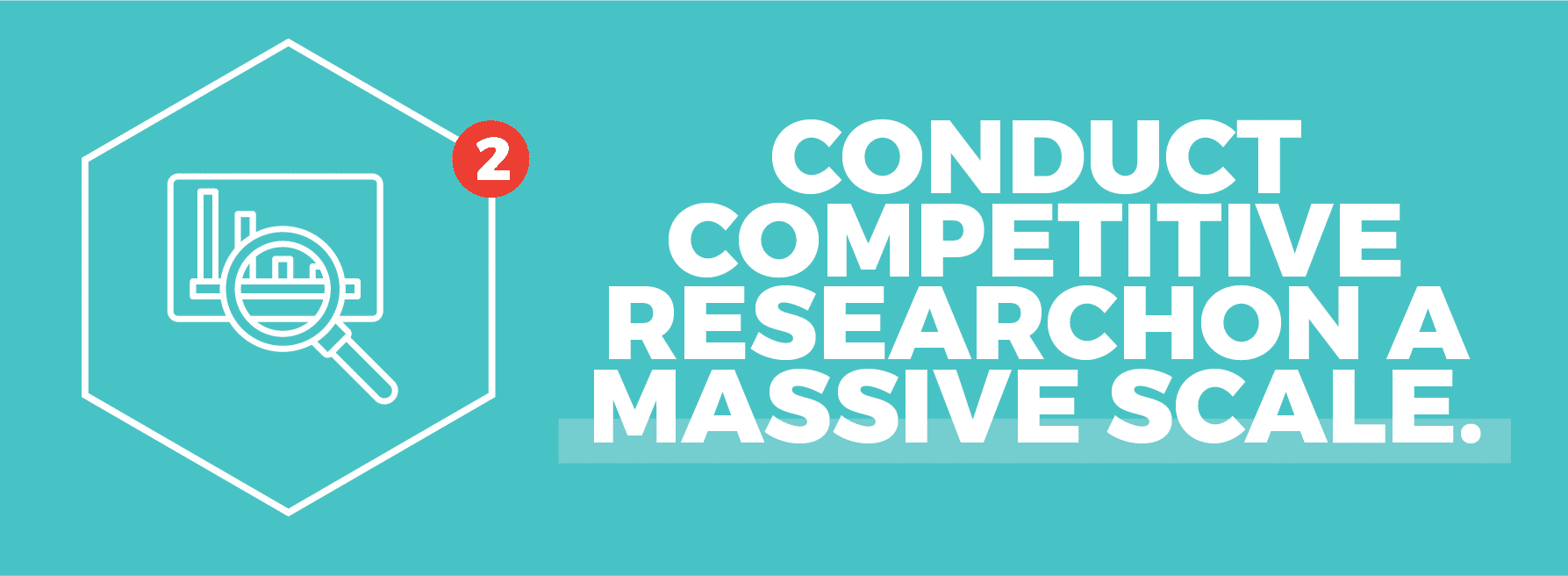Online competition is strong and continuously becoming fiercer. As digital tools evolve, so does the sophistication of the strategies employed.
The considerations run from social media ads, retargeting campaigns, Google searches, content and bylines, keywords, and much more. It’s enough to stress out any online marketer.
It’s particularly tough for e-Commerce marketers in the CPG (consumer packaged goods) space.
- There are traditional brands that have long histories of loyal followers and household name recognition.
- There are young, up-and-coming brands funded by outside investors.
In between these two extremes, there is a multitude of e-Commerce brands battling for the coveted number one spot. Seemingly everyone wants to sprint up the mountain, making their brand the dominant one in their industry.
e-Commerce companies need strong digital marketing to ensure that clicks to a sale are anywhere that their products or services are relevant.
When it comes down to it—online marketing is still just marketing. Your best bet is to try and silence the noise, get focused, and use the right tools to execute your strategy.
There are now many options that you can leverage to explore and analyze data. Data viewed from the right perspective helps generate more traffic and ultimately more sales.
Finding the right perspective is another noise issue. We’re going to show you how to cut through that noise and get straight to the signal!
Pro tip: Use ahrefs to analyze batches of media sites for PR link building.
Overview of Ahrefs’ Batch Analysis Tool
Ahrefs’ Batch Analysis Tool is one of the best tools for e-Commerce marketers, no matter the competition and their budget size.
The Ahrefs Batch Analysis Tool allows you to pull backlink metrics for up to 200 URLs in one search. It reports information back to you like Ahrefs Rank, Domain Rating, number of referring domains, number of backlinks and social metrics. Each of these metrics can help you design and execute a stronger SEO strategy.
How To Use Ahrefs’ Batch Analysis Tool
Ahrefs is probably the gold standard for backlink research. While it has expanded to assess other SEO components, its backlink data is an industry-standard. It’s an important part of the link building toolset. We use it ourselves at PureLinq.
The Batch Analysis Tool saves time because you can easily upload a spreadsheet of up to 200 URLs and generate reports on all of them at once. This is a powerful advantage—but knowing how to use it unlocks tactics that gives you a clear advantage over competitors.
We’ve assembled five ways to use Ahrefs’ Batch Analysis Tool for e-Commerce settings.

1. Leverage the power of Ahrefs even more
The Batch Analysis Tool is intended to help marketers get the deep knowledge they love from a typical Ahrefs backlink report, but scaled up to 200 domains. This is the crux of the tool, and why it’s so powerful.
The first step to making the most of this tool is to familiarize yourself with the main ways to use Ahrefs.
Explore several traditional backlink reports and discover how best to use the data. Once you’re comfortable using Ahrefs in this way, research and scale to your heart’s content. Use the Batch Analysis Tool to ramp up your efforts and support the detailed work you’re already doing with the rest of the platform.

2. Conduct competitive research on a massive scale
Competitor research is always a major component of any strong SEO strategy. You need to know who you’re fighting against and what their backlink profiles look like. This tool allows you to analyze their individual strengths and weaknesses to create the best SEO strategy for your clients.
Because e-Commerce clients are typically battling heavy competition, it becomes wastefully time intensive to pull backlink reports of each competitor one by one.
While this tactic may work for a couple of targeted top competitors, it’s best to scale the analysis to include a larger selection of competitors.
Scaling backlink analysis is where Ahrefs’ Batch Analysis Tool shines.
With the ability to analyze backlink profiles for up to 200 URLs simultaneously, you can explore all of the domains you need for competitive research on a scale that virtually assures that no important details will escape your notice.
If you’re looking for top-level data like domain rating, a number of referring domains, organic search traffic, and keyword rankings, this is it. This tool filters a huge amount of data at once and gives you quick access to the information you need to succeed.

3. Vet a huge list of link building prospects.
Ahrefs’ Batch Analysis Tool with filtering is a better approach to the conventional method of building links.
First, explore competitor link profiles with the tool to general hundreds of link building prospects by using it normally. Then upload your list and generate the top-level information.
After you have a list of prospects and their profiles, you can use the Batch Analysis Tool to sift and sort through all of these prospects. This will help you find the prospects that actually meet your criteria for the next steps.
Here’s how to do this:
- Take your link target list and enter it into the Batch Analysis Tool as a spreadsheet.
- Filter and sort the results by essential metrics that matter most to you. A few examples are listed below:
- Domain rating
- Total monthly traffic
- Referring dofollow domains
This method speeds up your link building process dramatically, and it’ll help you better target the prospects that can really make a difference in your strategy.

4. Evaluate sites/domains to purchase
Another powerful method for boosting the visibility of your e-Commerce site is acquiring sites/domains. This steps you a bit out of a conventional, straightforward link building process, but it’s a popular way to increase the potential of your profile.
However, buying sites can be expensive. You don’t want to wander into this without direction, as the costs can add up quickly. You need a plan.
Start by building a list of potential domains that you could purchase. Base your choices on the domain name, its age and other factors that you feel are pertinent to your e-Commerce project.
Next, plug this list of domains into Ahrefs’ Batch Analysis Tool and start vetting them in the same way that you’d consider which candidates to pursue link building.
Key metrics to consider include organic keywords, organic search traffic, and total backlinks. Strong candidates will emerge after you do this analysis, and you can then budget accordingly to purchase them.

5. Find killer guest posting opportunities
Guest blogging is still considered a smart tactic within any SEO strategy. It increases organic traffic, which is critical for any growing site and helps establish the authority that Google (and readers) can rely on. And, of course, there are valuable backlinks.
One of the first ways to begin finding guest blogging opportunities is simply by Googling. You can start off by searching your top keywords, followed by phrases like these:
- Guest post
- Submit a guest post
- Guest posting guidelines
This is a quick and easy way to start building a list of opportunities that you want to pursue. There are plenty of other guest blogging tips, but let’s explore what you can do with Ahrefs’ Batch Analysis Tool.
Ahrefs’ Batch Analysis Tool can allow you to quickly evaluate guest blogging opportunities.
Simply upload your list of targets and analyze the metrics.
By using the tool in this manner, you’ll be able to sift through a lot of noise and isolate the blogs with the most impact.
It’s also a great way to find hidden gems that fly under the radar in terms of popularity but have incredible “under the hood” metrics.
Batch Analysis is Best
Because of the specific challenges facing e-Commerce projects, Ahrefs’ Batch Analysis Tool is especially potent for e-Commerce. Competitors are vying for your online traffic.
Successful SEO strategies involve extensive competitive research. By using a tool that can quickly evaluate 200 URLs at once, you can access a vast amount of actionable data and gain a strategic advantage.
Bonus tip: Use the batch analysis tool in the organic asset marketing (OAM) strategy to analyze media opportunities in bulk, prioritizing sites based on potential SEO value.
FAQs
1. What does Ahrefs Batch Analysis provide for multiple domains?
Ahrefs Batch Analysis offers a comprehensive overview of key metrics for multiple domains, such as domain rating, backlink count, and organic traffic estimates. This allows for efficient comparison and analysis of potential sites for backlink opportunities.
2. Key features for PR link-building?
The tool streamlines PR link-building efforts by quickly evaluating the authority and relevance of multiple media sites, helping to identify the most valuable link-building opportunities.
3. Evaluating backlink quality?
Yes, it evaluates backlink quality using metrics like domain rating and the number of backlinks, helping users to prioritize high-quality sites for their link-building strategies.
4. Prioritizing outreach efforts?
Marketers can sort and filter analysis results by various metrics such as domain rating and organic traffic, allowing them to focus their outreach on sites with the greatest potential impact.
5. Insights into competitor SEO health?
Ahrefs Batch Analysis provides insights into competitors’ SEO strategies by analyzing their backlink profiles and organic search performance, offering clues on how to refine your own strategy.
6. Best practices for PR link building?
Focusing on media sites with high domain ratings and relevance to your niche can yield better results. Tailoring your outreach to match the site’s content and audience increases the chance of securing valuable backlinks.
7. Integration with other Ahrefs tools?
Data from Batch Analysis can be combined with other Ahrefs tools for a more detailed SEO strategy. For example, integrating with Site Explorer for deeper backlink profile analysis or with Keywords Explorer for content strategy refinement enhances overall marketing efforts.
By leveraging Ahrefs Batch Analysis in these ways, digital marketers can effectively enhance their PR link-building strategies and improve their overall online presence.



